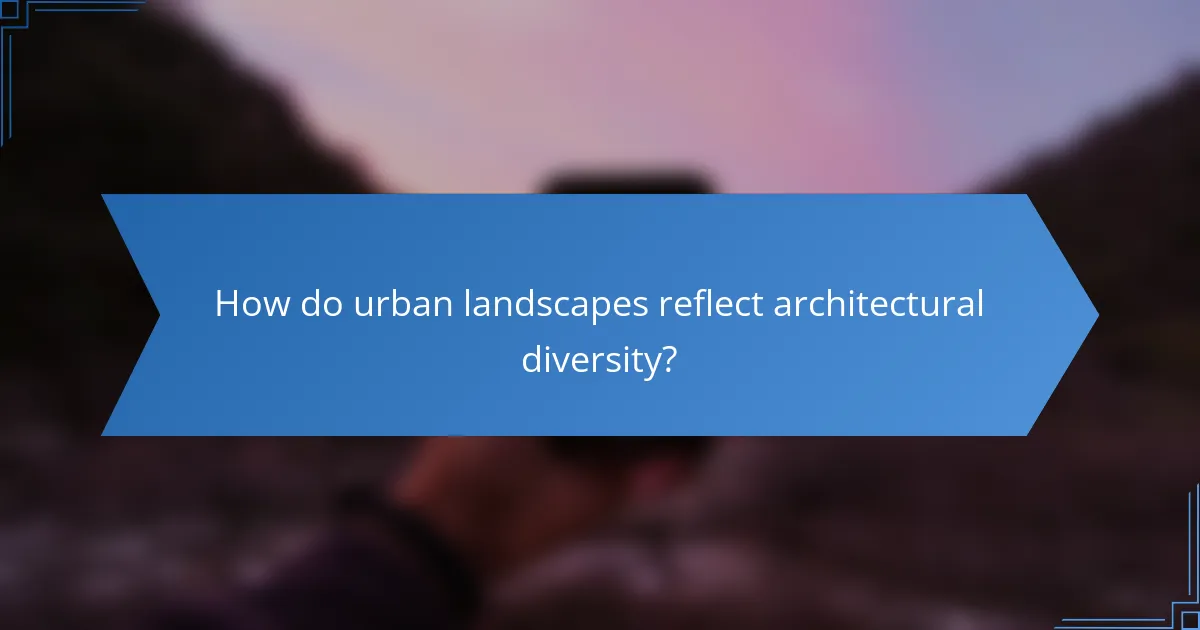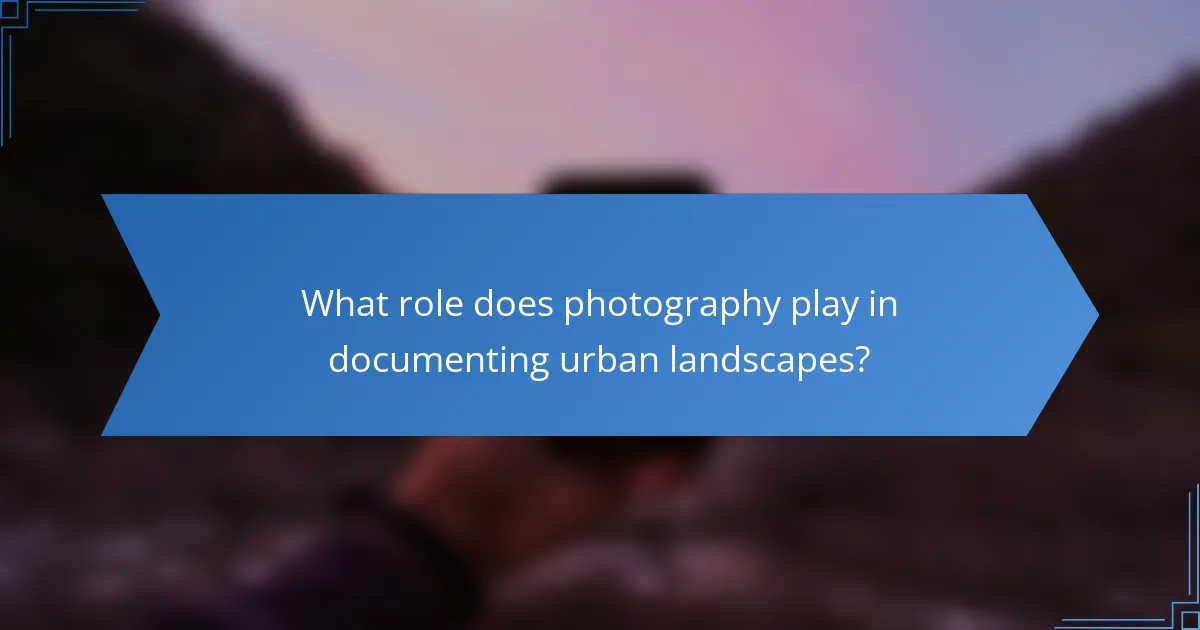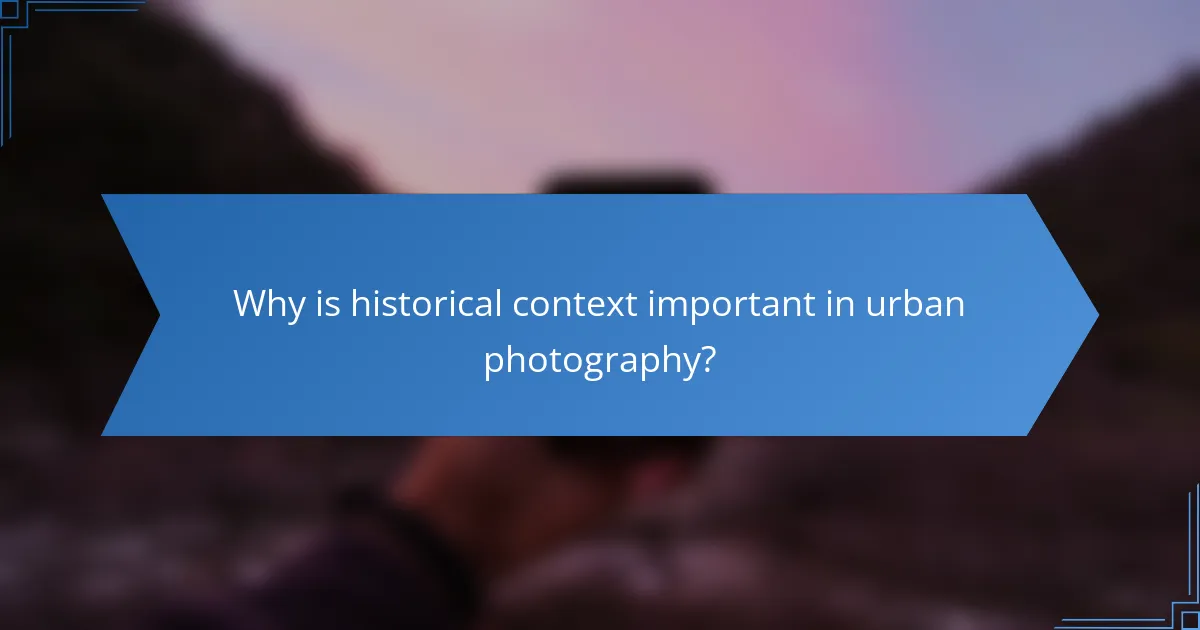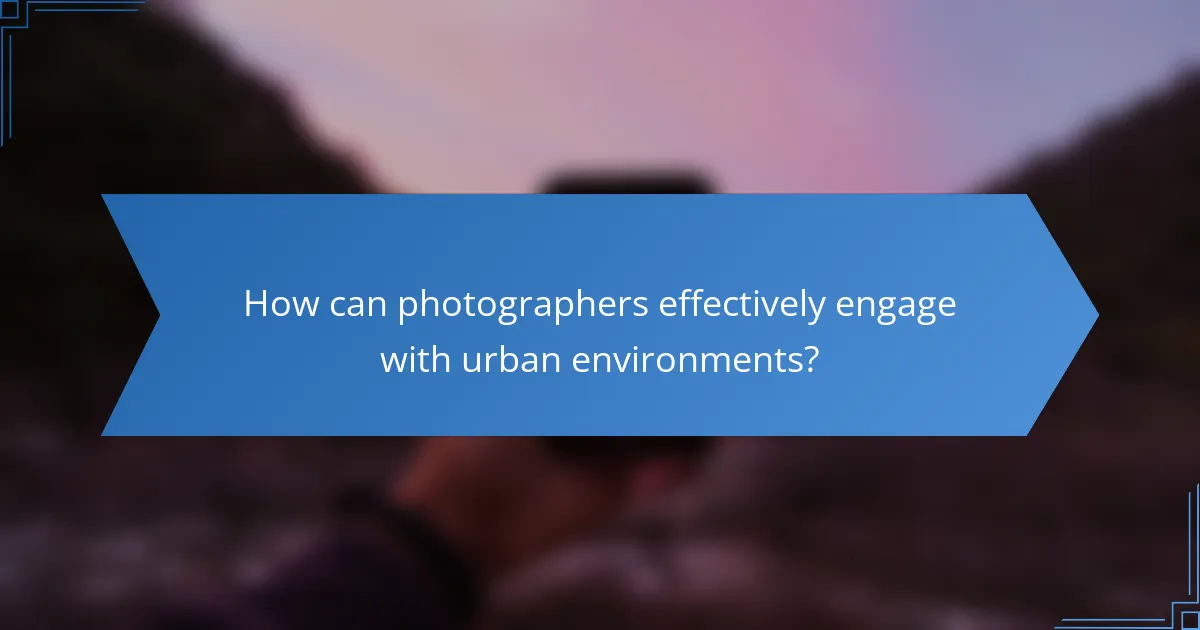Urban landscapes reveal the architectural diversity and historical context of cities through photography. This article explores how photography captures unique structures, reflects cultural influences, and documents the evolution of urban environments. It emphasizes the importance of historical context in enriching visual narratives and highlights rare attributes that contribute to a city’s identity. Additionally, it discusses techniques for photographers to engage with urban spaces effectively.

How do urban landscapes reflect architectural diversity?
Urban landscapes showcase architectural diversity by blending various styles, reflecting historical and cultural influences. Different building materials, designs, and layouts illustrate the evolution of urban environments. Photography captures these contrasts, highlighting unique attributes like colour, texture, and form. As a result, urban photography becomes a visual narrative of a city’s identity and heritage.
What are the key features of diverse architectural styles?
Diverse architectural styles showcase distinctive features that reflect cultural, historical, and environmental influences. Key features include materials, design elements, functionality, and aesthetic appeal.
Materials vary widely, from brick and stone to glass and steel, impacting durability and style. Design elements often encompass shapes, colours, and ornamentation, contributing to a building’s unique identity. Functionality addresses how spaces are utilised, influencing layout and accessibility. Aesthetic appeal engages viewers, often evoking emotional responses and connecting to local heritage.
Urban landscapes capture these features, illustrating the rich tapestry of architectural diversity across different regions and time periods.
Which elements contribute to the visual identity of urban areas?
Elements that contribute to the visual identity of urban areas include architecture, public spaces, landscaping, signage, and cultural landmarks. Each element reflects the city’s history, character, and functionality. Architectural diversity showcases various styles, while public spaces foster community interaction. Landscaping enhances aesthetics and environmental quality. Signage provides navigational clarity, and cultural landmarks serve as identity markers. Together, these elements create a cohesive urban landscape that influences perception and experience.
How does cultural heritage influence architectural choices?
Cultural heritage significantly influences architectural choices by shaping design elements, materials, and styles. Local traditions and historical contexts inform how buildings reflect community identity. For example, vernacular architecture showcases regional materials and techniques, while historical preservation maintains cultural narratives. This interplay creates urban landscapes that honour past influences while accommodating modern needs.

What role does photography play in documenting urban landscapes?
Photography plays a crucial role in documenting urban landscapes by capturing architectural diversity and historical context. It preserves the essence of cities, showcasing their evolution over time. Photographers highlight unique structures, styles, and urban narratives, creating a visual record that informs future generations. This visual documentation aids in understanding cultural heritage and urban planning, making it an essential tool for both artists and historians.
How can photography capture the essence of architectural diversity?
Photography captures architectural diversity by showcasing unique designs, materials, and cultural influences across different urban landscapes. This visual representation highlights the historical context and evolution of architecture, revealing how societies express identity through built environments. For example, contrasting modern skyscrapers with historical buildings illustrates the blend of innovation and tradition. Additionally, photography allows for the exploration of rare architectural styles, making them accessible to a broader audience. By framing diverse structures within their surroundings, photographers emphasize the relationship between architecture and urban life.
What techniques enhance the representation of urban spaces?
Techniques that enhance the representation of urban spaces include utilising diverse angles, emphasising light and shadow, and incorporating human elements. These methods capture architectural diversity and historical context effectively. For example, shooting during golden hour highlights textures and colours. Additionally, including people adds scale and liveliness to urban landscapes. Using leading lines can guide the viewer’s eye and create depth. These techniques collectively enrich the storytelling aspect of urban photography.
Which historical contexts are most effectively portrayed through photography?
Photography effectively portrays historical contexts by capturing urban landscapes, showcasing architectural diversity, and reflecting cultural evolution. Notable examples include the industrial revolution’s impact on cityscapes, the Art Deco movement in architecture, and the preservation of heritage through modern urban photography. Each of these contexts reveals social changes and historical narratives, allowing viewers to connect with the past visually.

Why is historical context important in urban photography?
Historical context is crucial in urban photography as it enriches the narrative and visual impact of architectural diversity. Understanding the history of a location allows photographers to capture the essence of urban landscapes, revealing how past events shape present structures. This context enhances appreciation for architectural styles and cultural significance, making images more compelling. For instance, knowing a building’s historical background can highlight its unique architectural features and the stories behind them. Ultimately, historical context transforms urban photography into a deeper exploration of identity and heritage.
How does understanding local history enrich photographic narratives?
Understanding local history enhances photographic narratives by providing depth and context. It allows photographers to capture not just buildings but the stories behind them. Historical knowledge informs composition, lighting, and subject choice, enriching the visual experience. For instance, recognising architectural styles can lead to more meaningful interpretations of urban landscapes. This connection between history and photography fosters a deeper appreciation for the cultural significance of structures, making images resonate more profoundly with viewers.
What are the challenges of capturing historical architecture?
Capturing historical architecture involves challenges like accessibility, preservation concerns, and evolving urban environments. Photographers often face restrictions due to private ownership or ongoing renovations that obscure original features. Additionally, varying light conditions and weather can impact the quality of images. Understanding historical context is essential for accurately representing the architecture’s significance.

Which unique attributes define specific urban landscapes?
Unique attributes defining specific urban landscapes include architectural styles, historical significance, cultural diversity, and spatial organisation. Architectural styles reflect local materials and design philosophies, while historical significance reveals the evolution of urban development. Cultural diversity showcases the blend of communities, influencing public spaces and local traditions. Spatial organisation highlights the layout and functionality of urban areas, impacting accessibility and livability.
What are the most iconic urban landscapes around the world?
Some of the most iconic urban landscapes include New York City, Paris, Tokyo, Sydney, and Istanbul. These cities showcase a blend of architectural diversity and rich historical context.
New York City features the striking skyline dominated by skyscrapers like the Empire State Building. Paris is renowned for its historic landmarks such as the Eiffel Tower and the Louvre. Tokyo offers a unique juxtaposition of traditional temples and modern architecture. Sydney is famous for the Sydney Opera House, a symbol of innovative design. Istanbul stands out with its blend of Byzantine and Ottoman architecture, including the Hagia Sophia.
These urban landscapes are not only visually stunning but also reflect the cultural narratives and historical evolution of their respective cities.
How do local materials and construction techniques influence urban aesthetics?
Local materials and construction techniques significantly shape urban aesthetics by reflecting cultural identity and historical context. The use of indigenous materials, such as brick or stone, often enhances visual harmony with the environment. Traditional construction methods can create unique architectural styles that tell stories of local heritage. Additionally, sustainable practices, like using reclaimed wood, can offer modern aesthetics while preserving history. Urban photography captures these elements, showcasing the diversity and richness of urban landscapes.

What are the rare attributes found in urban landscapes?
Rare attributes found in urban landscapes include unique architectural styles, historical significance, and ecological features. These aspects often reflect the cultural identity and evolution of a city. For example, some urban areas showcase rare combinations of modern and traditional architecture, creating visually striking contrasts. Additionally, specific cities may possess unique urban greenery, such as vertical gardens or community parks, enhancing biodiversity within the concrete environment. These rare elements contribute to the overall character and narrative of urban landscapes.
Which lesser-known architectural styles deserve more attention?
Several lesser-known architectural styles deserve more attention, including Brutalism, Deconstructivism, and Futurism. These styles offer unique perspectives on urban landscapes and reflect historical contexts often overlooked.
Brutalism emphasizes raw concrete and geometric forms, showcasing functionality over aesthetics. Deconstructivism challenges traditional architectural conventions, creating fragmented and chaotic structures that provoke thought. Futurism embraces technology and dynamism, often featuring bold lines and innovative materials.
Preserving and photographing these styles can enrich our understanding of architectural diversity and its historical significance. Each style contributes to the narrative of urban development, revealing societal values and aspirations through time.
How can photographers uncover hidden gems in urban settings?
Photographers can uncover hidden gems in urban settings by exploring lesser-known areas and focusing on unique architectural details. They should seek out abandoned buildings, hidden alleyways, and local neighbourhoods that showcase diverse styles. Engaging with local residents can reveal stories and locations not typically highlighted in guidebooks. Utilising different times of day can enhance lighting and reveal textures, while experimenting with angles can create fresh perspectives on familiar structures.

How can photographers effectively engage with urban environments?
Photographers can effectively engage with urban environments by exploring diverse architectural styles and historical narratives. They should seek unique perspectives that highlight contrasts between modern and traditional structures. Utilising natural light and shadows enhances the visual storytelling of urban landscapes. Additionally, understanding the cultural context of locations allows photographers to capture deeper meanings in their images. Engaging with local communities can provide insights and inspire authentic representations of urban life.
What are the best practices for photographing urban landscapes?
To photograph urban landscapes effectively, focus on composition, lighting, and context. Use leading lines to guide the viewer’s eye and capture the essence of architectural diversity.
Experiment with different angles and perspectives to highlight unique attributes of buildings. Early mornings or late afternoons provide optimal natural light, enhancing textures and colours.
Incorporate historical context by including elements that tell a story about the location. This adds depth and engages viewers, making the photograph more compelling.
Lastly, consider using post-processing techniques to enhance details and correct distortions, ensuring the final image reflects the intended vision.
Which common mistakes should photographers avoid in urban settings?
Photographers should avoid common mistakes such as poor composition, neglecting lighting conditions, and failing to research locations. These errors can diminish the impact of urban landscapes.
Not considering the foreground and background can lead to cluttered images. Ignoring the golden hour can result in harsh shadows and unflattering colours. Additionally, overlooking the historical context of architecture may lead to missed storytelling opportunities.
Lastly, not being adaptable to changing environments can hinder capturing unique moments. Embracing these considerations enhances the quality of urban photography.
How can urban photography contribute to community awareness and preservation?
Urban photography fosters community awareness and preservation by highlighting architectural diversity and historical significance. It captures the unique character of neighbourhoods, promoting appreciation among residents. This visual storytelling can inspire community engagement and advocacy for preservation efforts. Additionally, urban photography documents changes over time, serving as a valuable record of cultural heritage. By showcasing both the beauty and challenges of urban landscapes, photographers can motivate action toward sustainable development and conservation initiatives.